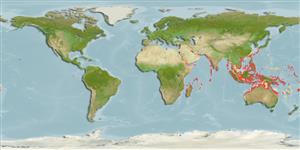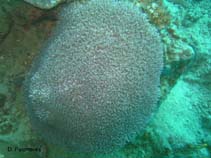Physogyra lichtensteini (Milne-Edwards & Haime, 1851)
Pearl bubble coral| Native range | All suitable habitat | Point map | Year 2050 |

|
| This map was computer-generated and has not yet been reviewed. |
| Physogyra lichtensteini AquaMaps Data sources: GBIF OBIS |
Classification / Names Common names | Synonyms | CoL | ITIS | WoRMS
Anthozoa | Scleractinia | Plerogyridae
Environment: milieu / climate zone / depth range / distribution range Ecology
Reef-associated; depth range 0 - 40 m (Ref. 847). Tropical; 30°N - 31°S, 32°E - 179°W (Ref. 847)
Distribution Countries | FAO areas | Ecosystems | Occurrences | Introductions
Indo-West Pacific: Japan to Australia and Red Sea to Fiji.
Length at first maturity / Size / Weight / Age
Maturity: Lm ? range ? - ? cm
Short description Morphology
Colonies are massive or form thick plates and meandroid in form with short, widely separated valleys. Tentacles are extended only at night and during the day the whole colony surface is covered with a mass of vesicles. Pale gray sometimes dull green in color.
Found in turbid environments (Ref. 847). Has very high bleaching level and high to near mortality of polyps in Palau (Ref. 66144).
Life cycle and mating behavior Maturity | Reproduction | Spawning | Eggs | Fecundity | Larvae
Mature gametes are shed into the coelenteron and spawned through the mouth. Life cycle: The zygote develops into a planktonic planula larva. Metamorphosis begins with early morphogenesis of tentacles, septa and pharynx before larval settlement on the aboral end (Ref. 833).
Main reference
References | Coordinator | Collaborators
Babcock, R.C. 2003. (Ref. 791)
IUCN Red List Status (Ref. 130435)
Vulnerable (VU) (A4cd); Date assessed: 03 January 2008
CITES status (Ref. 108899)
Appendix II: International trade monitored
CMS (Ref. 116361)
Not Evaluated
Threat to humans
Human uses
| FishSource |
Tools
More information
Internet sources
BHL | BOLD Systems | CISTI | DiscoverLife | FAO(Publication : search) | Fishipedia | GenBank (genome, nucleotide) | GloBI | Gomexsi | Google Books | Google Scholar | Google | PubMed | Hexacorallians of the World | Tree of Life | Wikipedia (Go, Search) | Zoological Record
Estimates based on models
Preferred temperature
(Ref. 115969): 25.1 - 28.2, mean 27 (based on 212 cells).
Price category
(Ref. 80766):
Unknown.



